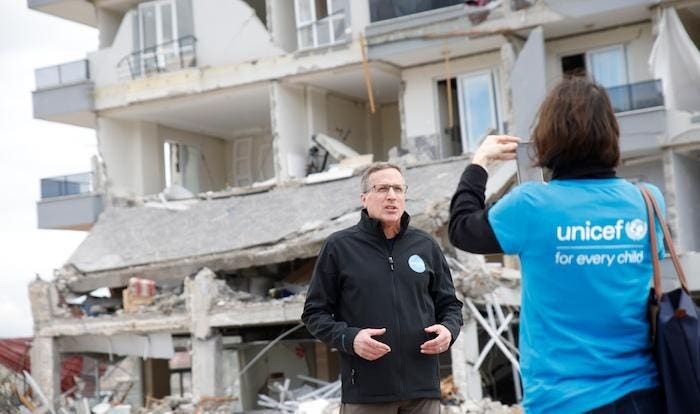The United States is currently undergoing a review of U.S. foreign assistance funding for effectiveness and alignment with U.S. interests. Let’s not mistake a review for a mandate to walk away.
UNICEF USA President & CEO Michael J. Nyenhuis reports live from Türkiye following a series of devastating earthquakes in 2023.
© UNICEF/UN0826490
I’d like to make the argument that U.S. leadership in global humanitarian aid and development assistance has been, and remains, incredibly valuable to our country and the world. By “U.S.,” I include both the American public, through its philanthropy and volunteerism, and our government, through funding commitments and technical expertise.
That leadership over the last decades has led to amazing results: the near elimination of diseases like polio and Guinea worm; dramatic reductions in child mortality; significant increases in the number of children, especially girls, in school; millions of lives saved during natural disasters and much more. Importantly, this work has also spread the values of peace, caring and generosity across the world.
U.S. foreign assistance funding, which represents about 1 percent of the federal budget, has been paused for a review of its effectiveness and alignment with U.S. interests. As a long-time professional in this sector, I welcome the review. Why wouldn’t we welcome a review? We stand behind the worth and effectiveness of the programs that have delivered these kinds of results. Yet, we all know, even good work can be done better. So, yes, let’s take a closer look and prioritize the programs that really work.
The argument I’d like to make begins with a moral one. It can be phrased in many ways, but I’ll reach into my faith tradition for these words: to those who have been given much, much is expected.
I interpret that to mean, in part, that nations like the United States that have great wealth, status and power have a responsibility to use those gifts to help lift up those who don’t have them. Certainly, this means taking care of the most vulnerable in our own society and creating real opportunity for everyone in our country to thrive. But it also means reaching out to those in other parts of the world who lack the resources, opportunities and advantages we, as a nation, have. In my view, it is not either/or but both/and.
For generations, the United States — both the public and its government — has lived up to that global responsibility, in part by being the largest contributor to humanitarian and development assistance programs globally. Our government has led other governments in that way. Our private sector donors and philanthropists have led as well. It is a legacy of which we can all be proud.
There are other arguments in support of U.S. leadership as well. Development assistance has often been seen as the third leg of the stool that supports U.S. foreign policy along with defense and diplomacy. Failed states and countries in crisis often lead to conflict that uproots families, creates flows of refugees, breeds terrorism and raises the risk that disease will spread across borders. Investments in health, education and economic opportunity counter all of this. Research has shown that a $1 investment in children and their well-being yields a tenfold societal return.
Another argument grounded in economics is also strong. Today, seven of the top 14 fastest growing economies are in sub-Saharan African countries that have been recipients of humanitarian and development assistance over the years. As the economies of these countries grow, they become markets for U.S. companies and important trading partners.
This recognition that humanitarian and development assistance is in U.S. interests (and is the right thing to do) has long had bipartisan support in the United States. It still does — especially when it is shown to be effective in delivering results for the people and nations receiving it and for the interests of the United States.
The nominee to be U.S. Ambassador to the United Nations recently echoed that support. The nominee, U.S. Rep. Elise Stefanik, said that when done well, this work advances U.S. national security interests and should continue to be backed by Americans. She used UNICEF, the world leader in child-focused programs, and the World Food Program (WFP), the leader in food aid, as examples.
“When it comes to those key questions: does it make America safer, stronger and more prosperous, I believe those are examples of programs that do,” Stefanik said. They maintain “bipartisan support,” deliver “significant results for millions around the globe” and strengthen “our national security,” she added.
I would argue that the work of many multilateral agencies like UNICEF, WFP and the World Health Organization, along with the international aid and development organizations and local agencies carrying out critical programs at the community level, help our country — and the world — become safer and more prosperous. But let’s see. Bring on the review.
In the meantime, let’s keep this critical lifesaving work going. In the world’s most vulnerable communities, children need their vaccines, pregnant moms need access to prenatal care, students need tools for better learning outcomes, parents need job training and access to capital.
The world still needs U.S. leadership in this area — from our government and from the public. And we as a country are well-served when we make these investments.
Michael J. Nyenhuis is the President and CEO of UNICEF USA.
Right now, the lives of vulnerable children hang in the balance. UNICEF’s work to save and protect them is made possible through support in the form of voluntary contributions from governments, intergovernmental organizations, foundations, the private sector and individuals. For decades, the U.S. Government has been a crucial partner in supporting UNICEF’s work to deliver results for children. Please contact your members of Congress and urge them to support ongoing U.S. investments in foreign assistance.





